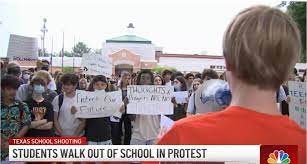In the wake of recent incidents involving guns on campuses, some U.S. students began their new semester by staging walkouts to protest gun violence — also a public health crisis which experts said has left persistent mental scars for child victims.

Holding signs of “Children shouldn’t die” and “Enough is enough,” students from San Francisco’s public high schools walked out of their classrooms on Friday afternoon to protest what they said are deficient security measures to prevent gun violence on campuses.
The action was a response to reports of firearms on two San Francisco high school campuses last month. In both cases, no one was hurt, but they renewed calls to beef up security systems in schools.
San Francisco students’ protest came less than two weeks after students across Iowa walked out of class to protest “lawmakers’ inaction on gun violence.”
A crowd of about 300 students, activists, lawmakers, and supporters, chanting “no more silence, end gun violence,” rallied at the Iowa State Capitol in Des Moines on Jan. 8.
The Iowa statewide walkout was held following the Jan. 4 deadly shooting at Perry High School, in which a 17-year-old student fatally shot an 11-year-old sixth grader, and wounded seven other people, including the school’s principal.
The students said the tragedy at Perry could have been prevented if lawmakers had taken legislative action in the wake of recent school-related shootings in Iowa.
They said they were worried about gun violence in their schools and felt firearms legislation in Iowa has put them in a vulnerable position.
The student protests precede one-year anniversaries of two mass shootings shocking California last January, which killed 11 and 7 people respectively in Monterey Park and Half Moon Bay.
U.S. President Joe Biden issued a statement for the two tragedies Sunday, touting his government’s efforts in the field of gun control.
“We launched the first-ever White House Office of Gun Violence Prevention, and my administration is implementing the Bipartisan Safer Communities Act — the most meaningful gun safety legislation in nearly 30 years — which strengthens background checks, expands the use of red flag laws, improves access to mental health services for students dealing with the trauma of gun violence, and more,” the statement said.
However, the United States has still by far the highest rate of gun deaths among wealthy countries. According to a new report by the National Institute for Health Care Management Foundation, more than 42,000 people died from gun-related injuries in 2023.
The year 2023 witnessed a record high in school shootings, outpacing the previous year’s record for the third year in a row. Last year, 346 school shootings were recorded by the K-12 School Shooting Database, which tracks gun violence on school grounds.
Just 20 days into this year, the organization has recorded 14 school shootings across the U.S. with 17 victims — almost half in Iowa.
The rapid increase in school shootings over the past three years has made gun violence the leading cause of death of children and teens in the United States since 2020, when it surpassed car accidents, according to the Kaiser Family Foundation’s analysis of the CDC data.
Anonymous tip lines in schools may help catch firearm-related threats by allowing students to report unusual behaviors or potential acts of gun violence to the system, according to a new study published in the journal Pediatrics on Wednesday.
The study examined more than 18,000 tips submitted to the reporting system in North Carolina from 2019 to 2023 and found that 10 percent of tips contained reference to a firearm.
Among the gun-related tips, 38 percent were about potential school shootings and nearly a quarter were about seeing or knowing of a weapon.
The researchers found 50 percent of the time gun-related tips require urgent response, and that is “significantly higher” than for non-gun-related tips.
The aftermath of nonfatal firearm injuries also poses a significant burden on families and the healthcare system and leaves persistent mental scars, according to a study, also recently released in Pediatrics.
The study identified 2,110 children with non-fatal gun injuries and found they had more than a five-fold increased risk for inpatient hospitalization, and they also experienced an increased risk of visits to hospital emergency departments and outpatient clinics.
After hospitalization from a nonfatal firearm injury, previous research shows that 50 percent of youth are discharged with a disability. The researchers said their findings will add to the growing body of research highlighting the significant economic and societal burden of youth firearm injuries.